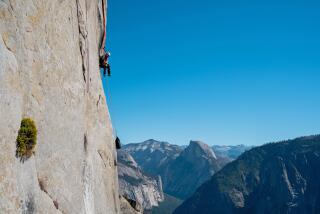New Name Doesn’t Hamper Firm’s Climb : Outdoor gear: Ignoring advice to give up, employees of troubled Chouinard Equipment pooled resources and started over.
- Share via
Owners of outdoor-equipment stores were decidedly pessimistic in the spring of 1989, when Chouinard Equipment, a Ventura-based maker of rock-climbing gear, floated a plan for a new company with a new name that would sell the same line of crampons, carabiners, ropes and ice axes Chouinard had sold.
“The typical response was, ‘Give up now, don’t even try,’ ” said Peter Metcalf, who was Chouinard’s general manager at the time. After all, many of the 75 store owners pointed out, Chouinard’s prestige was heavily dependent on its founder and owner, climbing guru Yvon Chouinard. A new name and a new company might not have the same appeal to climbers.
But with their company in bankruptcy court because of a spate of liability lawsuits, Metcalf and some other Chouinard employees--not including Chouinard himself--decided to go ahead and buy Chouinard’s assets last December in a leveraged buyout, in which the group borrowed most of the money for the purchase.
And Metcalf claims today that the newly formed company, Black Diamond Equipment Ltd., hasn’t suffered from the loss of its old prestigious name--an assessment even a competitor agrees on.
“In my opinion, they will pull through and they’ve done a great job at it,” said Helmut Lenes, owner of Climb High, a distributor of rock-climbing gear in Burlington, Vt.
The first public sign that Chouinard was in trouble came in April, 1989, when it filed for protection under Chapter 11 of the U.S. Bankruptcy Code, claiming that its hand was forced by five lawsuits blaming the company for deaths and injuries related to the use of its equipment.
Chouinard denied the charges, but Lost Arrow, Chouinard’s parent company--which owns the well-known Patagonia Inc. clothing company--believed putting Chouinard into bankruptcy reorganization was the only way to protect itself from the suits.
At least two of the lawsuits involved the deaths of climbers who were using a Chouinard-made harness--a beltlike device for attaching a climber to the rope--according to a filing by Daniel M. Blumenfeld, a Palo Alto attorney who represents plaintiffs in two of the cases in Chouinard’s ongoing bankruptcy proceedings.
One of the climbers, Arthur Calkins, a 48-year-old Northern California man, died in an accident at Pinnacles National Monument in California in February, 1989, according to the filing. After Calkins fell more than 100 feet, his harness “was found open, hanging near the top of the climb from where he had fallen,” the filing says.
Chouinard has denied responsibility for Calkins’ death, but Chouinard’s attorney in the case did not respond to telephone calls seeking comment.
As a new company that merely owns Chouinard’s former assets, Black Diamond has nothing to do with the lawsuits now--they are the problem of Chouinard itself, no longer a going concern, but only a corporation in bankruptcy.
About 42 former Chouinard employees used their retirement accounts for the acquisition and now own about 51% of Black Diamond, according to Metcalf, the new company’s chief executive. The rest is owned by investors and several business partners of the company, such as the owner of a French company that makes ropes. The group borrowed about 75% of the approximately $2.7 million needed to by Chouinard’s assets.
Metcalf admits that it wasn’t easy to borrow the money. But despite an interest rate of about 15% on the loan, he said Black Diamond has been paying it off and still remaining profitable.
In its final year of operations, Chouinard had sales of about $7 million, and Black Diamond’s sales for the year ending Aug. 30 will be about 10% higher than that, according to Metcalf.
Metcalf said the company has cut costs, such as liability insurance premiums. Black Diamond found a Seattle company that specializes in insuring ski resorts and other companies involved in high-risk sports that is charging Black Diamond only about a third of the $340,000-a-year Chouinard had to pay for nearly as much insurance coverage.
Black Diamond has also improved how it documents its quality control procedures. And the company now includes elaborate pictorial instructions with its products--if possible, sewn or imprinted right on the equipment. Black Diamond also includes explicit warnings with equipment and in its catalogue about the dangers of climbing.
To convey to customers the idea of a link between Chouinard and Black Diamond, the new company incorporated Chouinard’s logo--a letter “C” framed in a diamond--in its insignia.
So far, climbers seem to have caught on to the Black Diamond name. Climb High’s Lenes said he did not think his company had taken any of Chouinard’s share of climbing equipment market.
Lenes isn’t exactly sure why. But Metcalf said part of the reason is that Black Diamond geared its public explanation of the reorganization to appeal to climbers. Black Diamond has tried to reassure climbers that although it is a new company, “our collective experience in manufacturing great gear spans decades.”
Black Diamond also made a pitch to endear climbers to Black Diamond’s cause. A letter in its recent catalogue begins with the self-deprecating question: “What do a bunch of climbers know about leveraged buyouts?”
More to Read
Inside the business of entertainment
The Wide Shot brings you news, analysis and insights on everything from streaming wars to production — and what it all means for the future.
You may occasionally receive promotional content from the Los Angeles Times.










